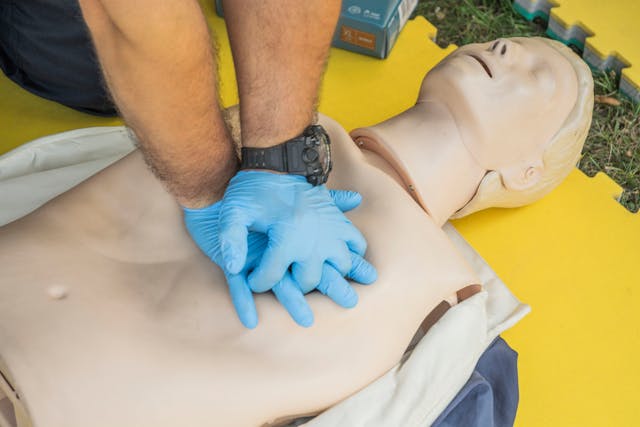
How does CPR work? CPR stands for cardiopulmonary resuscitation and it is a way to keep blood and oxygen circulating around someone’s body if their heart has stopped beating. It can be a way of keeping someone alive long enough for professional medical help to arrive.
The “cardio” part comes from the Greek word “kardia”, which means heart. “Pulmonary” comes from the Latin word “pulmo”, which means lungs. The idea and methods of trying to resuscitate someone have been around for thousands of years, but the abbreviation c.p.r. has only been used since 1960 when the name and the system were decided. Since then, we all learn rudimentary CPR at school, but most of us don’t know how to do it properly. This is changing, thanks to the prevalence of smartphones and the ability to find a YouTube video tutorial there and then, but a lot of people are still hesitant to perform CPR. The American Heart Association estimates that if everybody knew CPR, it would save roughly 200,000 lives a year. Performing CPR as soon as someone’s hope stops beating can double or triple the person’s chances of survival.
There are interesting statistics concerning this. 90% of our of hospital cardiac arrests are fatal, but that is because CPR is only performed 43% of the time, and often it is not properly performed. It has to be performed within 4 minutes of the heart stopping to increase the chance of survival and reduce the chance of brain damage from lack of oxygen. The percentages of people who receive CPR vary across gender, race, and wealth. Men are 1.23 times more likely to get CPR from a bystander than a woman is. This is largely down to people being unsure about touching a woman, even in such circumstances. White people are more likely to receive CPR than minorities. Wealthy people are more likely to receive CPR than poor people. This is probably down to the fact that more wealthy people are educated and are more likely to know how to perform CPR properly.
So, what does CPR do? When our heart is working, it takes in oxygenated blood from the lungs and pumps it on. It receives deoxygenated blood from the body and sends it on to the lungs. The heart is a muscle and each time it pumps, it contracts, pushing blood out into the arteries, sending it around the body. It pumps roughly 60 times a minute, every minute, for our entire life. All of the organs, especially the brain, need a constant supply of oxygen. If the heart stops, for whatever reason, that flow of oxygen stops instantly. All of the organs and the brain have to make do with whatever oxygen they are saturated with. All of our main organs need oxygen. The brain needs it to make ATP from carbohydrates, which is what keeps the neurons active. Without oxygen, the neurons start to die. The heart needs oxygen because it is a muscle and all muscles need oxygen so that they can function. The liver needs oxygen to metabolize chemicals and the kidneys need oxygen to filter waste products from the blood. All of our organs shut down without oxygen.
CPR consists of heart compressions and blowing air into the lungs. The heart compressions are a way of forcing the heart to pump blood and breathing air into the lungs keeps the blood as oxygenated as possible. Heart compressions will never be as good as the heart beating itself, but they are better than nothing. When you press down on the person’s chest, the pressure in the heart and the large blood vessels increases, which forces the blood on a little bit. These compressions have to be fast and they have to be firm. You should perform 100 to 120 compressions a minute. Singing the song “Stayin’ Alive” by the Bee Gees for a rhythm is good advice. Breaths should be given every 30 beats or so, but studies have shown that heart compressions alone are better than heart compressions with breaths. The heart is just the other side of the ribs, about 3 cm down. If you could get your hands around it and squeeze, it would be pretty easy to pump blood around the body. If you can get your hands around someone’s heart, though, then they have more problems than CPR can fix. To make the heart pump, you need to push very hard and about 40% of people who experience CPR have broken ribs. You have to pump the heart so fast and so firmly that it is extremely difficult to keep up. It may be a while before an ambulance arrives, and most people can’t keep up that pace. If there is more than one person around, then people should swap over every couple of minutes.
CPR is worth learning. 1 out of 4 people who receive CPR in a hospital survive. They have a lot more training and other equipment around, though. 1 out of 10 people who receive CPR out of the hospital survive. 10% doesn’t sound high, but that is 10% of people that would have died without CPR. And this is what I learned today.
Try these:
Sources
https://my.clevelandclinic.org/health/treatments/17680-cardiopulmonary-resuscitation-cpr
https://www.mayoclinic.org/first-aid/first-aid-cpr/basics/art-20056600
https://cpr.heart.org/en/resources/history-of-cpr
https://www.mycprcertificationonline.com/blog/cpr-success-rate
https://my.clevelandclinic.org/health/articles/17060-how-does-the-blood-flow-through-your-heart
Photo by SHOX art: https://www.pexels.com/photo/cpr-first-aid-cardiopulmonary-resuscitation-adult-pierwsza-pomoc-ratowanie-zycia-28271058/
